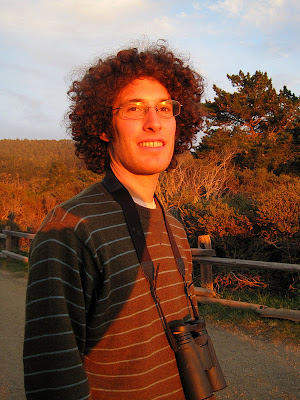Last Wednesday, January 4, we went out to the coast north of Santa Cruz to see the elephant seals at Ano Nuevo. We picked up Nick on the way. Año Nuevo State Park is the site of the largest mainland breeding colony in the world for the northern elephant seal.
Our first stop was the ranger outpost where we had an introduction to Ano Nuevo's Elephant Seals. Cassidy, one of Nick's housemates, gave a very fun presentation. She is holding a toilet seat that was cut off of an Elephant Seal's neck. More later on this seal, known as TS (not TP, Gail).
Cassidy explained how much of the bull Elephant Seal's chest skin is scar tissue from battling other males. The skull on the right is a bull Elephant Seal; the one next to it is a female skull.
Our guide wearing the red hat, Ranger Joe, led us on the one and a half mile trek out to the point where most of the colony is.
This is a video of the first e-seal we encountered up close. Sometimes, they haul up far into the dunes,
and are quite oblivious to people. Listen to this guy snore!
This bull is chasing off another bull closer to us. All the females are divided into just a few harems controlled by one bull each. Many bulls end up down the coast a bit at "Losers Beach".
It seems to take a lot of energy for these guys to move on land. Bulls reach a weight of 6,600 pounds, and a length of 16 feet. The cows are much smaller. This is the biggest male/female difference of any mammal.
Nick zooming in on the action.
Ranger Joe's enthusiasm was quite endearing. We heard him ask the group several times, "Has anyone seen Gray Whale calves in Magdelena Lagoon stick their heads up to the boat to have their chins scratched?
It's spiritual!"
The view down the coast toward Loser's Beach.
"The Lonely Bull".
The bull's nostrils hanging down to his mouth. The deepest recorded dive of an e-seal is 7,835 feet, and the males typically stay under for an hour (females 20 minutes).
Nick observing a bull in the dunes.
Part of the colony made up mostly of cows, juveniles, and pups.
Cows with nursing pups. Gulls and ravens scavenge afterbirth and dead animals.
The back end of a large bull. E-seals need a lot of fat as they don't eat during this time of the year.
Two bulls square off. "Looks like a 15 rounder!" shouted Ranger Joe. Note the puff of "steam" from the seal on the left.
The battle is on, as each seal tries to gouge their long canine teeth into the other's head and chest.
Ouch!
The victor chases the loser towards the water. This is a vulnerable time for the loser as he can have his precious tail flippers bitten severely.
Here, two calves are nursing from one mother, which is unusual. One of the calves lost it's mother and is nursing from this cow. Ranger Joe said that most likely one of the two calves would die. If a calve is separated from its mother by as little as 15 feet, it can be lost and eventually die.
Hence the name Elephant Seal!
Off the point is Ano Nuevo Island. The house, now occupied by e-seals and sea lions, used to be for the lighthouse which is no longer there. Sea lions actually go upstairs, and have been seen in the bathtub. The e-seals can't climb stairs, so stick to the ground floor. You can see e-seals on the beach in front.
You can see the battle scars on this bull's chest and neck.
E-seals occasionally flip sand on their backs. This is thought to act as a sunscreen to keep them cool.
On the trek back, we encountered TS. Joe said he is a loner who is not interested in anymore stress in his life. You can see the scar around his neck from the toilet seat that slowly cut into him as he grew.
Back at the ranger kiosk, I had to see what it would be like to be bitten by a bull e-seal.













































